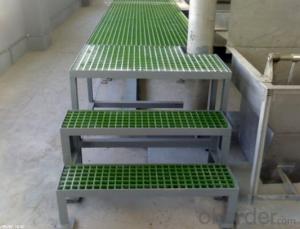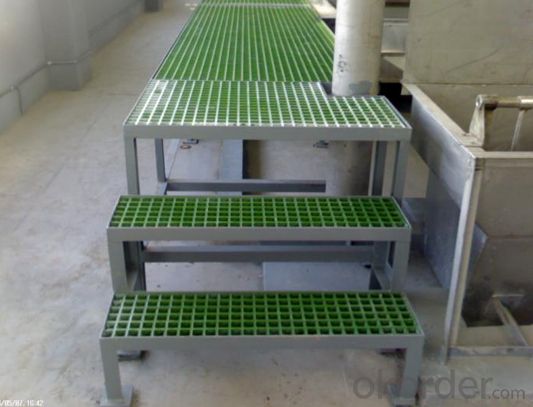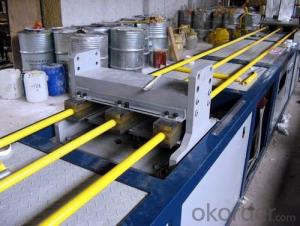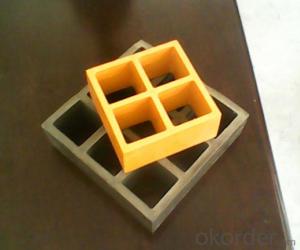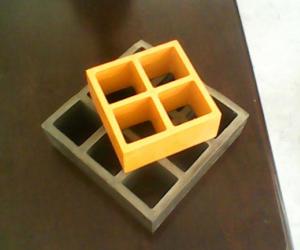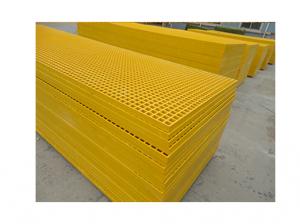FRP Pultrusion Profiles - Fiberglass Grating in Different Colors (Green, Red, Blue)
- Loading Port:
- Shanghai
- Payment Terms:
- TT or LC
- Min Order Qty:
- 1000 m.t.
- Supply Capability:
- 30000 m2 m.t./month
OKorder Service Pledge
OKorder Financial Service
You Might Also Like
Product description of FRP Grating
FRP Grating, Molded FRP Grating, Fiberglass Grating, GRP Grating,GRP Molded Grating,FRP Pultrusion Grating, FRP Mini Mesh Grating,Trench Grating, Drain Grating,Grating Walkway, Platform Grating...
Comparing with other floor materials, FRP molded grating provides a series of benefits, unmatched impact resistance,
while the strength-weight-ratio is only one-fourth of that of steel grating. It is easy to cut and install.
Specification of FRP Grating
Item | Thickness mm | Mesh Size mm*mm | Panel Size mm*mm | Weight kg/Square Meter |
01 | 15 | 38*38 | 1223*3660 | 7 |
02 | 15 | 50*50 | 1223*3660 | 6.5 |
03 | 25 | 25*100 | 1010*3010 | 12.4 |
04 | 25 | 19*19 | 1223*3660 | 12.5 |
05 | 30 | 19*19 | 1223*3660 | 21.5 |
06 | 30 | 38*38 | 1223*4040 | 15.1 |
07 | 38 | 19*19 | 1223*3660 | 22.8 |
08 | 38 | 38*38 | 1000*4040 | 19.5 |
09 | 38 | 38*38 | 1223*3660 | 19.5 |
10 | 40 | 40*40 | 1250*3690 | 19.3 |
11 | 50 | 50*50 | 1223*3660 | 21.5 |
Images
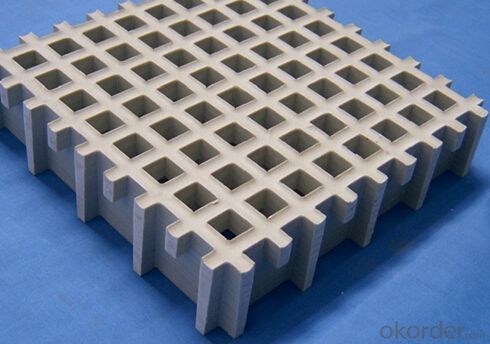

Features
1.Corrosion and Chemical resistant
2.Slip-resistant
3.High strength-to-weight ratio
4.Ergonomic
5.Low maintenance
6.Fire retardant
7.Easily fabricated and installed
FAQ:
1. Why Choose us?
CNBM is a stated own company, provide the guarantee for the best quality, best service and safety business.
2. How will we guarantee the quality?
a, ISO 9001-2008 quality control system;
b, Strict and regular quality control in production;
c, Inspeciation when loading into container before shippment;
d, Sample stock for one year for quality tracing and record.
3. Can you provide sample?
Yes, samples are in stock. we can offer free sample for you.
- Q: How do FRP pultrusion profiles perform in extreme humidity conditions?
- FRP pultrusion profiles perform exceptionally well in extreme humidity conditions. The fiberglass-reinforced plastic material used in the profiles is highly resistant to moisture absorption, preventing any degradation or dimensional changes. This makes them ideal for applications in humid environments, as they maintain their strength, durability, and structural integrity over time.
- Q: What are the typical dimensions and sizes of FRP pultrusion profiles?
- The dimensions and sizes of FRP pultrusion profiles may vary depending on the application and manufacturer. However, there are some common ranges to consider. Concerning dimensions, the length of FRP pultrusion profiles can range from a few feet to several tens of feet, depending on the project requirements. The width or height of the profiles can vary greatly depending on the intended use, but typical dimensions usually fall within 0.5 inches to 12 inches. The size of FRP pultrusion profiles is determined by their cross-sectional area, usually measured in square inches. The cross-section can take on various shapes, such as rectangular, square, round, or custom designs. Typical sizes of FRP pultrusion profiles can range from as small as 0.1 square inches to as large as 100 square inches or more. It's worth noting that manufacturers can create custom-made FRP pultrusion profiles to meet specific project requirements. They have the flexibility to produce profiles with unique dimensions and sizes, ensuring they align with the specific needs of the application. Therefore, it's advisable to consult with the manufacturer or supplier to determine the most suitable dimensions and sizes for a specific FRP pultrusion profile.
- Q: What are pultrusion materials used for?
- Pultrusion is a kind of glass fiber forming process, the main raw materials are glass fiber and resin
- Q: How do FRP pultrusion profiles compare to traditional materials, such as steel or aluminum?
- FRP pultrusion profiles offer several advantages compared to traditional materials like steel or aluminum. Firstly, FRP profiles are significantly lighter in weight, making them easier to handle and transport. This characteristic is especially beneficial in applications where weight reduction is crucial, such as in aerospace or automotive industries. Moreover, FRP pultrusion profiles are highly corrosion resistant, unlike steel which is prone to rusting and aluminum which can corrode in certain environments. This corrosion resistance makes FRP profiles ideal for applications in harsh or corrosive environments, such as chemical plants or coastal areas. Another advantage of FRP pultrusion profiles is their excellent strength-to-weight ratio. Despite being lightweight, FRP profiles exhibit high strength and stiffness, often surpassing steel and aluminum. This strength allows for the design of structurally efficient components, reducing material and installation costs. Furthermore, FRP profiles are electrically non-conductive, offering inherent insulation properties. This feature makes them suitable for applications where electrical conductivity is undesirable, such as electrical cabinets or offshore platforms. In terms of thermal conductivity, FRP pultrusion profiles have low thermal conductivity compared to metals. This characteristic improves insulation and reduces heat transfer, making them suitable for applications requiring temperature control or insulation, such as refrigeration or thermal insulation systems. Lastly, FRP pultrusion profiles are highly customizable. They can be easily molded into complex shapes and sizes, allowing for design flexibility and meeting specific project requirements. This versatility makes FRP profiles suitable for a wide range of applications, including construction, infrastructure, and industrial sectors. Overall, FRP pultrusion profiles offer numerous advantages over traditional materials like steel or aluminum, including lighter weight, corrosion resistance, high strength-to-weight ratio, electrical insulation, low thermal conductivity, and design flexibility. These benefits make FRP profiles a preferred choice in various industries, providing cost-effective and reliable solutions.
- Q: What are the circumstances in which the pultrusion should be performed?
- The roving yarn assembly in yarn frame, yarn unwinding through a series of guide roller and cluster grid plate, roller set, enter the resin impregnated resin impregnated yarn groove. Then through the pre forming die, the die is required according to the shape of products and configuration in the guiding device. The mold after discharge excess resin and bubbles into the cold. Cold mold cooling by cooling water, so that the resin viscosity, reduce the loss, and finally into the mold, the fiber reinforced material and resin molding in mold curing, and then the traction device is pulled, cut into required length of products by cutting device.
- Q: Can FRP pultrusion profiles be used in protective barriers?
- Yes, FRP (Fiber Reinforced Polymer) pultrusion profiles can be used in protective barriers. FRP pultrusion profiles offer excellent strength, durability, and corrosion resistance, making them suitable for various applications including protective barriers. They can withstand impact, extreme weather conditions, and chemicals while providing a lightweight and cost-effective solution for barriers in industries such as construction, transportation, and safety.
- Q: Are FRP pultrusion profiles resistant to moisture absorption?
- FRP pultrusion profiles possess remarkable resistance to moisture absorption, primarily due to the composition of the materials used in their construction. These profiles typically consist of a combination of fiberglass and resin, wherein fiberglass is naturally non-porous and impervious to moisture, while the resin is specifically designed to repel moisture. The moisture resistance of FRP profiles is further enhanced by the pultrusion manufacturing process. This process involves pulling the fiberglass and resin through a heated die, ensuring thorough impregnation of the fibers with resin and creating a dense and solid structure. Consequently, the resulting product exhibits exceptional resistance to water penetration and moisture absorption. Additionally, the moisture resistance of FRP pultrusion profiles can be augmented through the application of protective coatings or surface treatments, such as gel coats or UV-resistant finishes. These coatings provide an extra layer of defense against moisture ingress. The superior moisture resistance of FRP pultrusion profiles makes them an ideal choice for applications that involve exposure to water or high humidity, such as marine environments, wastewater treatment plants, or outdoor structures. By preventing issues like rot, rust, or degradation commonly associated with materials like wood or metal, these profiles offer a reliable and durable solution that can endure moisture exposure without compromising their structural integrity or performance.
- Q: Can FRP pultrusion profiles be used in the renewable energy and solar power industry?
- Yes, FRP (Fiber Reinforced Polymer) pultrusion profiles can be used in the renewable energy and solar power industry. These profiles offer several advantages such as high strength, durability, corrosion resistance, and lightweight properties, making them suitable for various applications in the industry. FRP pultrusion profiles can be used for structural components, support structures, mounting systems, and other applications in solar panels, wind turbines, wave energy devices, and other renewable energy systems.
- Q: Are FRP pultrusion profiles resistant to hydraulic oils?
- Yes, FRP pultrusion profiles are generally resistant to hydraulic oils. The combination of fiberglass reinforcement and resin matrix used in pultrusion manufacturing makes these profiles highly resistant to various chemicals, including hydraulic oils. However, it is recommended to consult the specific resin manufacturer or supplier for detailed information on the compatibility of their FRP pultrusion profiles with different types of hydraulic oils.
- Q: Are FRP pultrusion profiles resistant to moisture?
- FRP pultrusion profiles possess an exceptional ability to withstand moisture. During the manufacturing process, fiberglass reinforcements are saturated with a resin matrix, usually polyester, vinyl ester, or epoxy. These resins naturally repel moisture, making FRP pultrusion profiles well-suited for a wide range of applications that involve exposure to moist or humid environments. Unlike conventional materials like wood or steel, FRP does not absorb water, eliminating the risks of swelling, warping, or corrosion. This moisture resistance is particularly advantageous in sectors such as construction, infrastructure, and the marine industry, where profiles may encounter rain, saltwater, or high humidity. Moreover, the resin matrix employed in FRP pultrusion can be fortified with additives or coatings to enhance its moisture resistance further. For instance, UV inhibitors can be incorporated to safeguard against degradation caused by sunlight exposure. Fire-retardant coatings can also be applied to fulfill specific safety requirements. In summary, FRP pultrusion profiles offer outstanding moisture resistance, establishing them as a resilient and dependable choice for applications where moisture exposure is a concern.
Send your message to us
FRP Pultrusion Profiles - Fiberglass Grating in Different Colors (Green, Red, Blue)
- Loading Port:
- Shanghai
- Payment Terms:
- TT or LC
- Min Order Qty:
- 1000 m.t.
- Supply Capability:
- 30000 m2 m.t./month
OKorder Service Pledge
OKorder Financial Service
Similar products
Hot products
Hot Searches
Related keywords
